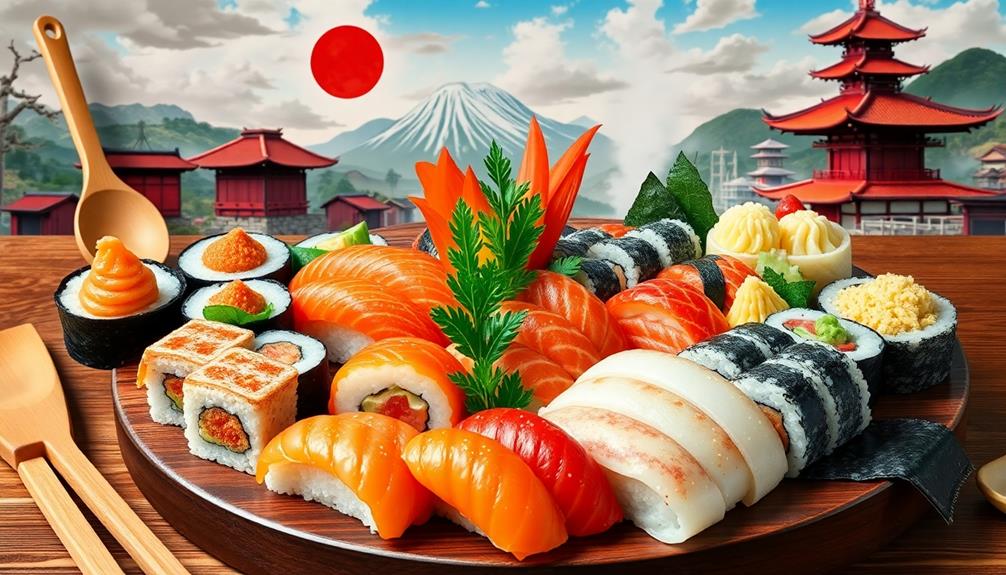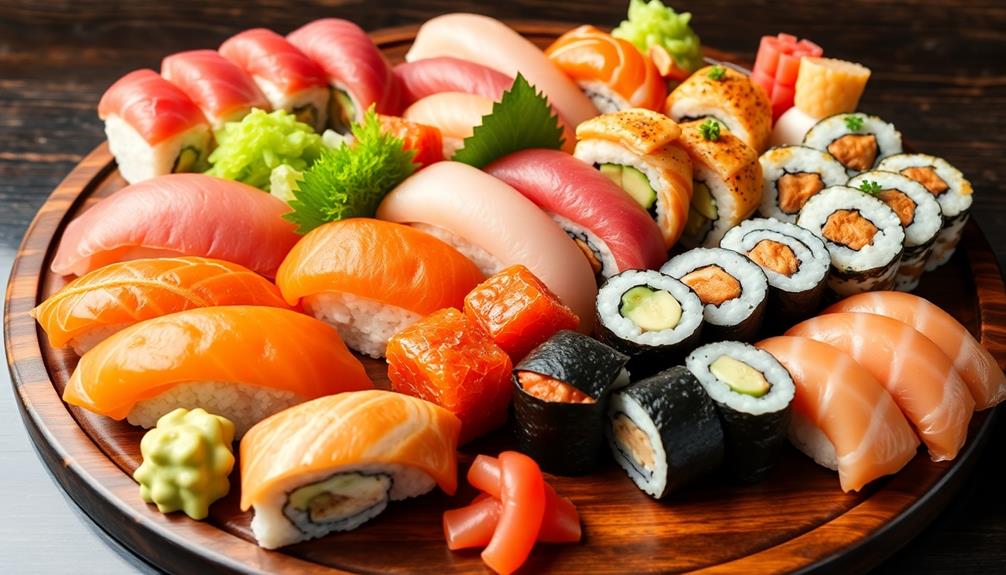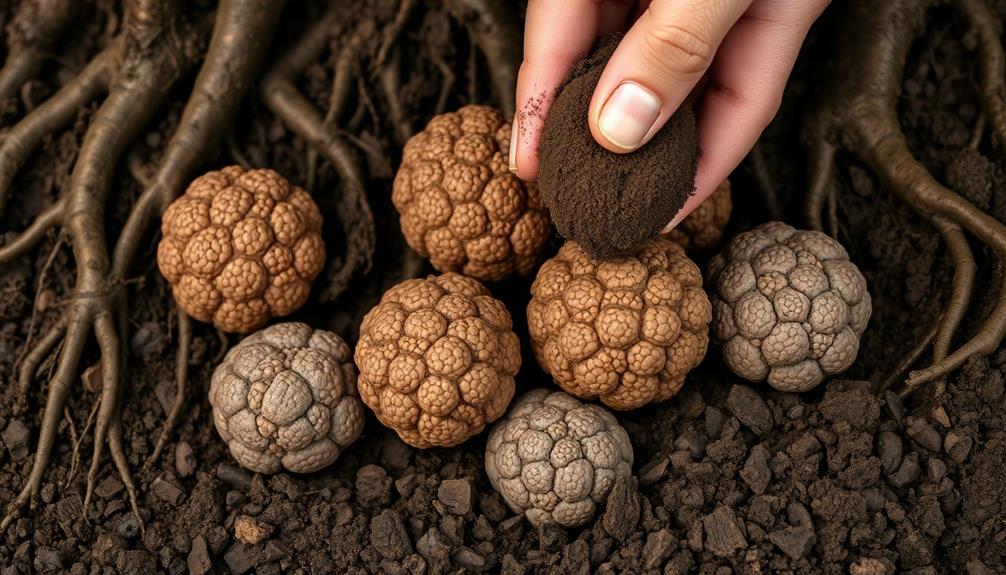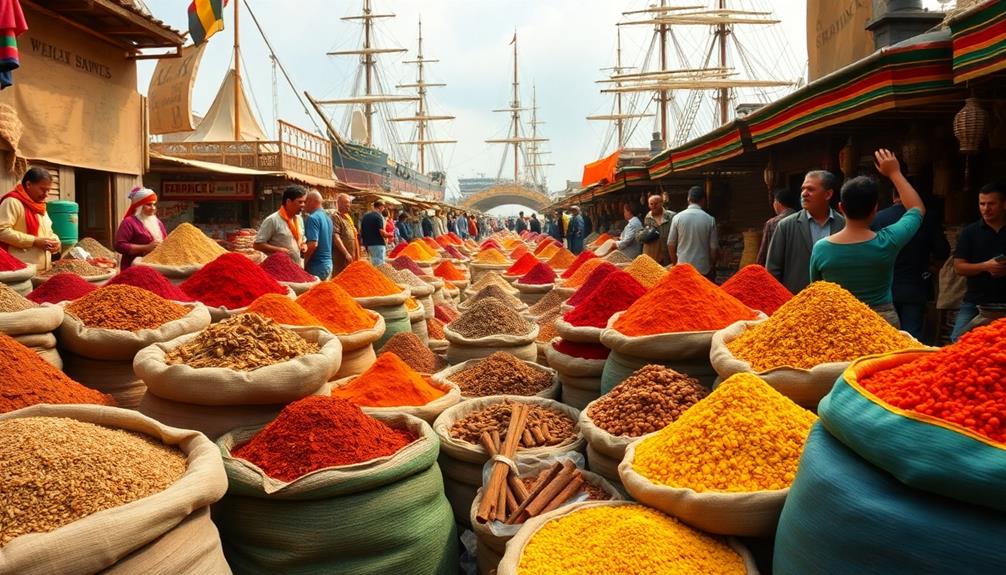Sushi's history is surprisingly rich, starting as a fish preservation method in ancient Southeast Asia around the 2nd century BC. It made its way to Japan by the 8th century, where local techniques enhanced its flavors. The Edo period transformed sushi into what you know today, especially nigiri, which was perfect for quick meals. This beloved dish reflects Japan's culinary artistry and tradition. As sushi evolved, it gained global popularity, leading to creative variations like the California roll. If you're curious about how sushi continues to evolve and adapt, there's more to explore in its fascinating journey.
Key Takeaways
- Sushi originated in Southeast Asia as a fish preservation method using fermented rice around the 2nd century BC.
- The Edo period transformed sushi into nigiri, making it more convenient for urban consumption with fresh fish atop hand-formed rice.
- Sushi reflects Japan's cultural identity, often served at celebrations and showcasing the artistry of skilled chefs.
- The California Roll popularized sushi in Western markets, leading to diverse adaptations and fusion styles globally.
- Modern sushi trends include plant-based options and innovative formats like sushi burritos, emphasizing sustainability and creativity.
Origins of Sushi

Sushi's origins trace back to Southeast Asia around the 2nd century BC, where it began as a practical method for preserving fish through fermentation with rice, known as narezushi. This technique used fermented rice and salt to store fish without refrigeration, which was essential in ancient times.
As you explore the history of sushi, you'll find that this preservation method laid the groundwork for what would become a beloved culinary tradition. Similar to how Dorayaki (Red Bean Pancake) evolved into a popular snack, sushi underwent significant changes over time.
By the 8th century, sushi made its way to Japan, where it evolved alongside local culinary practices. The Japanese integrated the concept of fermented rice and fish into their diet, enhancing the flavors and techniques further.
During the Edo period (1603-1868), sushi transformed dramatically, leading to the creation of nigiri—hand-formed rice topped with fresh fish. This new style made sushi quicker and more accessible for everyday consumption.
The history of sushi is more than just a story of food; it's tied to rice's cultural significance in Japan, once used as currency. This connection illustrates how sushi has deep roots in Japanese society, making it not just a dish but a symbol of tradition and heritage.
Cultural Significance in Japan

When you think about sushi in Japan, you can't overlook the years of rigorous training sushi chefs undergo to perfect their craft. Each technique they master isn't just a skill; it's an art form that reflects a deep cultural appreciation for culinary mastery.
This dedication to preparation and presentation elevates sushi beyond mere food, making it an essential part of Japan's cultural identity.
Similar to how Red-Braised Pork Belly showcases the rich flavors of Chinese cuisine, sushi embodies the meticulous attention to detail found in Japanese culinary traditions.
Culinary Mastery Training
Starting on a journey to become a sushi chef in Japan means entering a world where culinary mastery is revered as an art form. As a budding chef, you'll find that the training is rigorous, often stretching over ten years. This commitment is essential for mastering the intricate techniques needed to create traditional sushi.
Every detail matters—from selecting the freshest fish to perfecting the seasoning and texture of the rice. Similar to the meticulous preparation found in dishes like Mushroom Masala, the focus on fresh, high-quality ingredients is paramount. You'll learn that each step in the sushi-making process is a distinct art form, emphasizing Japan's deep cultural respect for culinary skills. This meticulous preparation reflects broader culinary philosophies that prioritize freshness, seasonality, and reverence for natural ingredients.
As you explore deeper, you'll witness how sushi isn't just a meal; it's woven into the fabric of Japanese society, often served at special occasions and celebrations, underscoring its cultural significance.
The dedication and craftsmanship of sushi chefs earn them respect comparable to that of artists, showcasing Japan's appreciation for culinary mastery. By embracing this journey, you'll not only hone your skills but also connect with a rich cultural heritage that values food as a essential expression of identity.
Art of Preparation
The art of sushi preparation in Japan transcends mere cooking; it's a discipline steeped in tradition and cultural significance. As you explore this culinary world, you'll find that each step—from selecting the freshest fish to perfecting sushi rice—requires years of rigorous training. The respect for sushi chefs, known as itamae, underscores their essential role in this craft.
Sushi preparation embodies an artistic discipline where every detail counts. The ideal texture and flavor of sushi rice are achieved through meticulous seasoning with vinegar, sugar, and salt, showcasing the chef's skill. Presentation, too, reflects a deep appreciation for seasonality and freshness, crafting each piece to evoke harmony and balance.
Here's a quick overview of the sushi preparation process:
| Step | Importance |
|---|---|
| Selecting Fresh Fish | Guarantees quality and flavor |
| Preparing Sushi Rice | Critical for texture and taste |
| Crafting Each Piece | Reflects harmony and artistry |
| Presenting the Dish | Enhances the dining experience |
Through these practices, you can see why sushi preparation is not only about food; it's about cultural identity and artistic expression.
Evolution and Adaptation

Sushi's journey from narezushi in Southeast Asia to the beloved dishes we enjoy today highlights its remarkable transformation.
This evolution is reminiscent of how traditional Thai street food, like Khanom Tan, has adapted over time to various cultural influences and local ingredients.
You'll notice how it adapted to local tastes and ingredients, especially during the Edo period and after World War II, when it embraced global influences. During the Edo period, Japanese cuisine began incorporating more soy sauce and miso, while after World War II, it started to include elements from Western and Chinese cuisine. This fusion of influences has resulted in a diverse and delicious culinary tradition. Additionally, Japanese cuisine has also retained some of its ancient uses of spices, such as wasabi and shichimi togarashi, which add unique and traditional flavors to the dishes.
As sushi continues to evolve, it reflects modern dietary preferences and sustainability efforts, showcasing its versatility.
Historical Transformation of Sushi
Over centuries, sushi has transformed from a practical preservation method into a global culinary phenomenon. It began in Southeast Asia around the 2nd Century BC as narezushi, using fermented rice and salted fish. This method evolved in Japan during the 8th century, but the Edo period (1603-1868) truly revolutionized sushi with the creation of nigiri, bite-sized pieces of fresh fish on vinegared rice.
Remarkably, just as traditional Italian dishes like agnolotti showcase regional ingredients and culinary skills, sushi also emphasizes fresh, local catches and seasonal produce. Hanaya Yohei's innovation in the 18th century further refined sushi into convenient, hand-shaped portions.
After World War II, sushi made significant strides in Western markets. The introduction of the California roll played an important role in this shift, using familiar ingredients to attract a broader audience.
Today, sushi continues to adapt, embracing modern trends and dietary preferences.
- Narezushi: The origin of sushi as a preservation method
- Nigiri: A response to fast-paced urban life
- Hanaya Yohei: The innovator of modern sushi forms
- California Roll: A bridge between cultures
- Sustainability: A focus for contemporary sushi practices
This rich history illustrates how sushi has evolved while maintaining its essence, showing its ability to adapt to changing tastes and times.
Global Fusion and Variation
As sushi gained momentum around the world, it began to embrace a variety of flavors and culinary traditions, leading to exciting new fusion styles. The California roll, created in the 1970s, was a game changer, making sushi more accessible by substituting ingredients like avocado and crab for raw fish. This innovative approach eased diners into eating raw fish, helping sushi restaurants thrive in the West.
Similar to how Chilaquiles represent leftover tortillas, sushi has also adapted traditional ingredients to create new and exciting dishes.
As interest grew, Latin American-inspired sushi emerged, blending traditional techniques with bold flavors from Mexican and Peruvian cuisines. You'll also find modern sushi variations catering to vegetarian and vegan diets, offering delicious dish options that maintain traditional textures and flavors.
Innovative formats like sushi burritos and sushi bowls have transformed casual dining, reflecting how sushi adapts to contemporary taste preferences.
Additionally, global sushi competitions spur culinary creativity, encouraging chefs to experiment with new flavors and presentations. This constant evolution highlights how sushi isn't just a dish; it's a dynamic cuisine that continues to surprise and delight food lovers around the globe.
Embrace these variations, and you'll discover a world of sushi that's more diverse than ever!
Global Popularity and Trends

The global popularity of sushi has skyrocketed in recent years, transforming it into a $20 billion market as of 2021. From its ancient roots in Japan, sushi has now made its way into diverse culinary cultures worldwide.
You can find over 4,000 sushi restaurants in the United States alone, demonstrating how far it's come. This culinary evolution mirrors the rise of other global cuisines, such as Brazilian cuisine, which also showcases a rich blend of cultural influences and flavors.
- The California roll helped introduce sushi to Western diners, using familiar ingredients like avocado and crab.
- Modern trends have led to creative dishes such as sushi burritos, sushi bowls, and sushi donuts.
- Plant-based sushi options cater to vegan and vegetarian diets, aligning with growing health and sustainability interests.
- Social media platforms showcase visually stunning sushi, expanding its reach and encouraging culinary experimentation.
- Sushi's adaptability to contemporary tastes continues to drive its global popularity.
This evolution reflects how sushi has embraced change while still paying homage to its origins.
As you explore sushi today, you'll see a fusion of tradition and innovation, making it a dynamic choice for food lovers everywhere.
Types of Sushi

Sushi comes in various forms, each offering a unique taste experience that reflects both traditional Japanese techniques and modern culinary creativity. Immerse yourself in the world of sushi, and you'll discover delightful options that cater to every palate.
| Type of Sushi | Description |
|---|---|
| Nigiri | A small mound of vinegared rice topped with a slice of fresh fish, often paired with wasabi. |
| Maki | Rolled sushi with rice and fillings wrapped in seaweed, sliced into bite-sized pieces. |
| Sashimi | Thinly sliced raw fish served without rice, showcasing the seafood's freshness. |
| Temaki | A hand-rolled cone of seaweed filled with rice and ingredients, perfect for a fun dining experience. |
Each type presents a different way to enjoy fish and rice, whether you prefer the simplicity of sashimi or the interactive fun of temaki. Uramaki, or inside-out rolls, have also made waves in Western culture, often featuring popular ingredients like crab and avocado. Exploring these diverse forms of sushi can truly enhance your appreciation for this beloved cuisine.
Future of Sushi

While traditional sushi techniques have stood the test of time, the future is bright with innovation and creativity.
You'll notice ongoing experimentation with traditional and non-traditional ingredients, appealing to diverse palates as culinary trends evolve. As chefs embrace sustainability, they'll prioritize local and seasonal ingredients, combating overfishing while enhancing flavor and freshness. This shift mirrors the principles of farm-to-table cooking, emphasizing the use of fresh, local produce that elevates the dining experience.
Expect to see a rise in plant-based sushi alternatives, catering to the health-conscious and expanding the sushi experience for vegan and vegetarian diners. Innovations in sushi preparation, like technology and robotics, will likely improve efficiency and creativity in sushi production.
Here are some trends to watch for in the future of sushi:
- Increased use of local, seasonal ingredients for sustainability.
- A wider variety of plant-based sushi options to meet dietary preferences.
- Fusion styles that blend sushi with global cuisines.
- Technology-driven sushi production enhancing quality and consistency.
- Creative presentations and flavor combinations that surprise the palate.
Embracing these developments won't only keep sushi relevant but also allow it to flourish in an ever-changing culinary landscape.
Frequently Asked Questions
What Are 5 Interesting Facts About Sushi?
You'll find sushi's fascinating journey includes its origins as a preservation method, the rise of nigiri, California rolls introducing raw fish to the West, a booming market, and innovative plant-based variations catering to diverse tastes.
What Is the True Origin of Sushi?
Did you know sushi's origins trace back to Southeast Asia around the 2nd Century BC? Its evolution in Japan led to fresh nigiri by the Edo period, blending preservation techniques with local culinary traditions.
What Is Unique About Sushi?
Sushi's uniqueness lies in its blend of flavors, textures, and presentation. You'll appreciate the artistry involved, from the freshness of ingredients to the meticulous techniques sushi chefs employ, turning each bite into a culinary experience.
Was Sushi Originally Eaten With Hands?
Eating sushi's like savoring a delicious secret; yes, sushi was originally eaten with hands. This practice preserved the fish's delicate texture and made it easy for street vendors to serve quick meals on the go.
Conclusion
To sum up, sushi's journey from humble beginnings to a global sensation mirrors the saying, "You can't make an omelet without breaking a few eggs." Each evolution has shaped its cultural significance and flavors. As you savor your next sushi roll, remember that it's more than a meal; it's a blend of history and tradition, continuously adapting to the tastes of the world. With its popularity soaring, the future of sushi is bound to be just as exciting.










